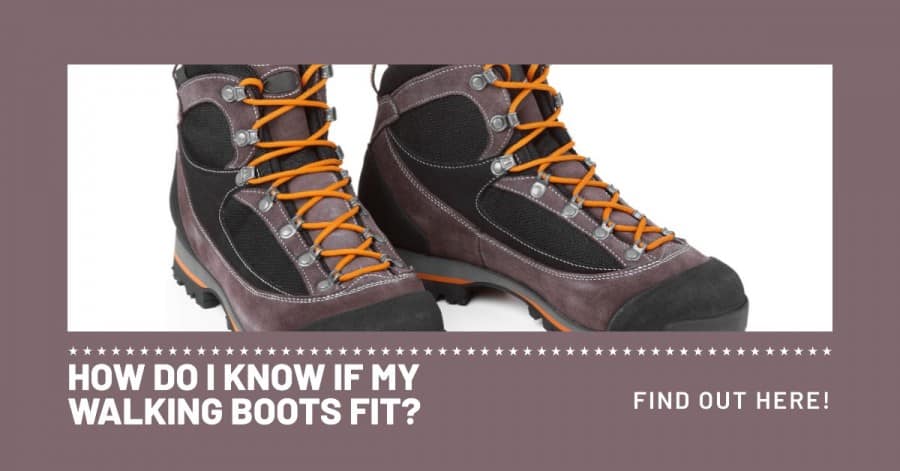Table of Contents
Some links on posts are affiliate links and will earn us a commission from qualifying purchases
It’s a common question every first-time hiker asks themselves when buying walking boots: do they fit? Getting the right pair of walking boots is essential to ensure a safe and comfortable experience on your hikes. But don’t worry – there are plenty of ways you can make sure that those new walkers are going to fit correctly! In this blog post, we’ll break down some key points to consider when it comes to making sure your footgear has the perfect fit. Read on for more information and guidance on how to get ready for your next outdoor adventure!
Understand the importance of having a properly fitting walking boot
As hikers, we understand the importance of having a comfortable and well-fitting pair of walking boots. After all, our feet are our most important tool when it comes to taking on those challenging trails and exploring the great outdoors. So, how can we determine if our walking boots fit properly?
Firstly, make sure that you are wearing proper hiking socks when trying on boots, as this will affect the fit. Secondly, take time to measure your feet – both in length and width. Walking boots should fit snugly, but not too tight or too loose. This allows for proper circulation, prevents friction, and reduces the risk of blisters.
Another tip is to make sure there is enough room in the toe box to wiggle your toes, but not so much that your feet slide around. It’s also important to test the boots on different terrains, as a boot that feels comfortable in the store may not hold up on a steep incline or rocky surface.
In summary, taking the time to properly fit walking boots can make all the difference on your hikes and outdoor adventures.
Identify the different parts of a walking boot and their roles in comfort and performance
Getting the perfect fit isn’t just about comfort, it’s about preventing injuries, blisters, and discomfort. You’re going to be spending long hours on your feet, so getting the right size and shape is important. The upper section of your walking boot, for instance, should fit snugly around your ankle to provide you with the necessary support, without being too tight.
The lacing system should also enable you to adjust the fit, providing further support when needed. As for the midsole, it’s got to be firm enough to support your arch but still provide enough cushioning to ensure your feet don’t get too tired.
When testing out the outsole, walk around on the surface you intend to explore, as you’ll need to ensure that the grip is best suited for your terrain. When it comes to the insole, know that it can be removed for added customization. Try out different insoles with varying thicknesses and arched support to find what works best for you.
Such details may seem trivial, but they add up to make the difference between a tough trek and a comfortable stride.
Learn how to properly measure your feet to ensure the right size is chosen
Ill-fitting boots can quickly ruin your hiking experience, causing blisters, discomfort, and even injuries. To avoid these issues, the first thing you must do is measure your feet. Not only should you measure the length of your feet, but also the width and arch.
When trying on boots, be sure to wear the same type of socks that you’ll be wearing on your hike and walk around the store or your house to get a feel for the fit. A snug fit is important, but be mindful that you don’t want your toes to be cramped. Additionally, look for boots that have good ankle support, as hiking terrains can be uneven and put pressure on your ankles.
With proper measurement and fitting, you can have a comfortable and enjoyable hiking experience.
Know what width and depth measurements you need for a comfortable fit
Not only do you need boots that are comfortable, but they also need to provide the necessary support and protection for your feet while traversing steep and rugged terrain. So, what should you keep in mind when it comes to width and depth measurements?
Firstly, it’s crucial to measure your feet when they’re at their largest – usually at the end of a day of activity – to ensure you get the most accurate measurements. You should also take into account any specific foot conditions or concerns you may have, such as bunions or plantar fasciitis, as this will impact the fit of the boots.
High-arched feet require deeper boots, as they need more space for support, while those with flat feet may need wider boots to accommodate the foot’s shape. It’s also important to try on boots with the same thickness of sock you’ll be wearing on your hike, as this will impact the overall fit.
Finally, don’t be afraid to try on different brands and styles to find the one that suits your unique needs and preferences. By prioritizing the right measurements and taking the time to find the perfect boots, you can ensure that your hiking experience is not only comfortable but also safe and enjoyable.
Analyze the weight distribution of your boots when you walk – it should be equally balanced with no pressure points or discomfort
Have you ever stopped and analyzed the weight distribution of your boots when you walk? It may sound like a small detail, but it can make a huge difference in your overall comfort and foot health. Ideally, your boots should distribute your weight equally, without any pressure points that cause discomfort or pain.
The key is to ensure that your weight is spread equally across the sole of your boot. A well-balanced shoe will not only make your walk more enjoyable but also prevent any potential injuries caused by improper weight distribution. So, take a moment to check your boots and make sure they’re providing the support and comfort your feet need.
Try on several different styles to make sure you find the right ones for your individual needs
When it comes to finding the perfect pair of shoes, it’s important to ensure you try on several pairs to make sure you find the right one. No two feet are the same, and what works for one person might not work for another. By trying on several different styles, you’ll be able to get a better idea of what works for your individual needs.
Don’t be afraid to explore different colours, fabrics, and shapes to find the perfect pair. Whether you’re looking for something comfortable for everyday wear or something stylish for a special occasion, trying on several different pairs will help you find the perfect fit.
Whether you are just starting to walk or you have been doing it for years, the proper fitting walking boot is essential. You should understand the different parts of a stride and be aware of your foot measurements.
Comfort and performance depend on knowing the correct width and depth dimensions to ensure a well-balanced fit that redistributes your body weight without any discomfort. Take the time to try on several pairs so you can find the ones that meet all of your requirements. A good pair of walking boots should last several years with proper care.
Conclusion
Whether you are just starting to walk or you have been doing it for years, the proper fitting walking boot is essential. You should understand the different parts of a stride and be aware of your foot measurements. Comfort and performance depend on knowing the correct width and depth dimensions to ensure a well-balanced fit that redistributes your body weight without any discomfort. Take the time to try on several pairs so you can find the ones that meet all of your individual requirements. A good pair of walking boots should last several years with proper care – take a look at our buyers guide for more information so you can get the perfect pair!
Recent Posts
Have you ever gone hiking and been really frustrated because your boots are so heavy? Well, you're not alone. A lot of people don't realize how much their walking boots weigh until they start...
Do you love hiking, but find that your boots always seem to rub your ankles the wrong way? If so, relax – you’re not alone. In fact, this is a common issue that many hikers face. Fortunately,...


